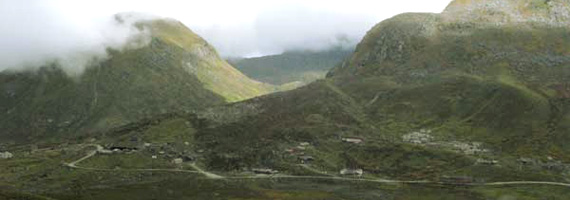
Jelep La is a high altitude mountain pass at 13,999 feet linking Lhasa to India. It nestles between India and Tibet in the eastern part of the Sikkim in India. The word Jelep La is of Tibetan origin and it means “the lovely level pass”. It is truly the most level among all the passes between Sikkim and Tibet.
The beautiful Menmecho Lake flows below the Jelep La Pass. One can savor the awesome sight of the pass, while coming from New Baba Mandir to Kupup Lake, just after crossing the Menmecho Lake on the GN Road. There are some small military settlements at the Jelep La Pass. The complete trail from Jelep La Pass to the Kupup Lake is visible.
At the Indian side, Jelep La features two routes. One runs through Kalimpong and the other through Gangtok. The Kalimpong route is the older one and it passes across the pristine towns of Pedong in Northern part of West Bengal, Rhenok and Kupup. The Kalimpong route has played a pivotal role in the upliftment of local economic condition, as it was used for trading furs and wool, till early last century. However, the route has been closed down after the Sino-Indian War in 1962. The route from Gangtok, crosses the towns of Sherathang, close by Changu Lake and alongside Nathu La and through Kupup.
The route is quite spectacular, admired with forests of rhododendron, which in spring are in full bloom. A number of pristine hamlets dot the panoramic surrounding. On the Tibetan side, the path stretches towards Chumbi Valley of the Tibetan Plateau.
From ancient time, Jeep La Pass is playing a major role as a trade route with the flourishing trade relation, between India and Tibet. When British started to rule India, they built roads in Sikkim around 1884. In the year 1886, a small Tibetan armed force occupied the area around the pass. In May 1888, the British were attacked by the force but were warded off. However, late in the same year, in the month of September the British reoccupied the area around the pass.
With the rising influence of Russia in Tibet, the British sent an expedition in 1904, via Jelep La to Lhasa, headed by Colonel Francis Younghusband. This expedition was confronted by formidable Tibetan forces. However, the British defeated them. In the absence of the 13th Dalai Lama, who had escaped to Mongolia, a trade agreement was forced on the Tibetans.
In 1947, when India gained independence, Sikkim was a monarchy. During this time, Sikkim was granted a special protectorate status and India owned the status of a suzerain nation. From that point onwards, the defense and foreign affairs of Sikkim are managed by India. After the invasion of Tibet by China in 1950, the passes in Sikkim were used by the refugees coming from Tibet. However, after the Sino-Indian War in 1962, the Jelep La Pass was closed down permanently.
In the early phase of 1975, following a referendum, Sikkim became a part of India. Again, with the recent development in relation between India and China, there are possibilities in reopening the Jelep La Pass (following the reopening of the Nathu La Pass on July 6, 2006). There is a huge expectation that the opening of the pass, will lead to an economic boom in the region.
